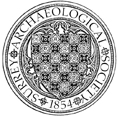Evaluation by G Webster of ASE revealed six ditches, two pits, and an irregular deposit. One of the ditches contained medieval pottery, another Late Iron Age pottery, which was considered to be residual; all the features and the irregular deposit contained slag, which suggests the presence of a medieval metalworking site in the vicinity. A subsequent strip, map and sample identified three phases of activity on the site. The earliest evidence dates from the Late Iron Age/early Roman period, with linear features representing a field system and a potential routeway.
